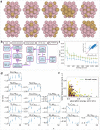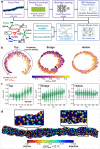Machine Learning-Assisted Low-Dimensional Electrocatalysts Design for Hydrogen Evolution Reaction
- PMID: 37831203
- PMCID: PMC10575847
- DOI: 10.1007/s40820-023-01192-5
Machine Learning-Assisted Low-Dimensional Electrocatalysts Design for Hydrogen Evolution Reaction
Abstract
Efficient electrocatalysts are crucial for hydrogen generation from electrolyzing water. Nevertheless, the conventional "trial and error" method for producing advanced electrocatalysts is not only cost-ineffective but also time-consuming and labor-intensive. Fortunately, the advancement of machine learning brings new opportunities for electrocatalysts discovery and design. By analyzing experimental and theoretical data, machine learning can effectively predict their hydrogen evolution reaction (HER) performance. This review summarizes recent developments in machine learning for low-dimensional electrocatalysts, including zero-dimension nanoparticles and nanoclusters, one-dimensional nanotubes and nanowires, two-dimensional nanosheets, as well as other electrocatalysts. In particular, the effects of descriptors and algorithms on screening low-dimensional electrocatalysts and investigating their HER performance are highlighted. Finally, the future directions and perspectives for machine learning in electrocatalysis are discussed, emphasizing the potential for machine learning to accelerate electrocatalyst discovery, optimize their performance, and provide new insights into electrocatalytic mechanisms. Overall, this work offers an in-depth understanding of the current state of machine learning in electrocatalysis and its potential for future research.
Keywords: Algorithm; Descriptor; Hydrogen evolution reaction; Low-dimensional electrocatalyst; Machine learning.
© 2023. Shanghai Jiao Tong University.
Conflict of interest statement
The authors declare no interest conflict. They have no known competing financial interests or personal relationships that could have appeared to influence the work reported in this paper.
Figures










References
-
- Ligani Fereja S, Li P, Zhang Z, Guo J, Fang Z, et al. W-doping induced abundant active sites in a 3D NiS2/MoO2 heterostructure as an efficient electrocatalyst for urea oxidation and hydrogen evolution reaction. Chem. Eng. J. 2022;432:134274. doi: 10.1016/j.cej.2021.134274. - DOI
-
- Zhao B, Liu J, Xu C, Feng R, Sui P, et al. Hollow NiSe nanocrystals heterogenized with carbon nanotubes for efficient electrocatalytic methanol upgrading to boost hydrogen co-production. Adv. Funct. Mater. 2020;31(8):2008812. doi: 10.1002/adfm.202008812. - DOI
-
- Wu Y, Wei W, Yu R, Xia L, Hong X, et al. Anchoring sub-nanometer Pt clusters on crumpled paper-like mxene enables high hydrogen evolution mass activity. Adv. Funct. Mater. 2022;32(17):2110910. doi: 10.1002/adfm.202110910. - DOI
Publication types
LinkOut - more resources
Full Text Sources
